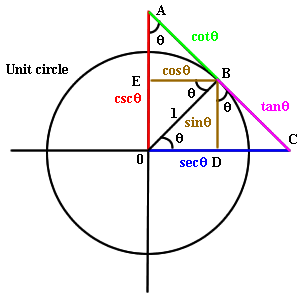| |
|||||
Sine is opposite over hypotenuse in a right triangle.
There are four other trigonometric functions defined geometrically as in the illustration here
They are related to one another as can be deduced from the
picture by looking at similar triangles. sin Thus the tangent of an angle in the first
quadrant is the length of the (tangent) line perpendicular
to one side of that angle at distance one from its center,
to the other side of the angle. Exercises: 2.6 Derive the relations between these functions by using similar triangles. Solution 2.7 What are the appropriate signs for each of these functions in the different quadrants? Solution 2.8 Find an alternative expression for (tan x + cot x)2. Solution 2.9 Which triangles are similar to OBD? Solution |
||||||||||||||||||||||||||

